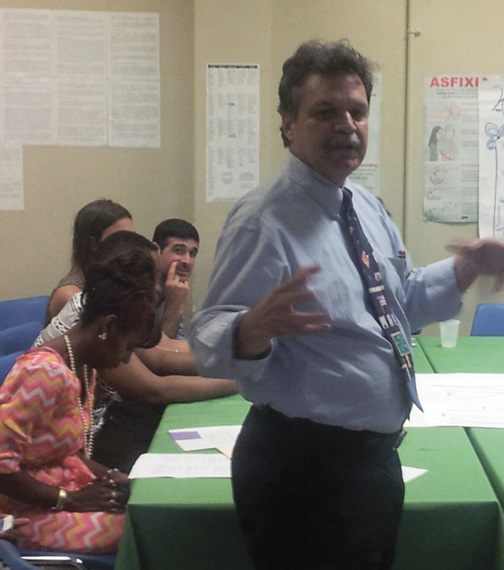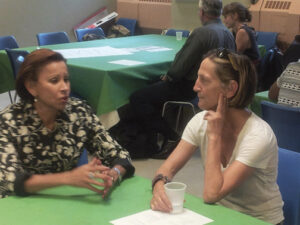On the evening of Monday, June 23, roughly 30 Red Hook residents, community organizers, and politicians met at the Miccio Center to discuss progress on the Long-Term Community Recovery Plan. This project, funded by the Red Hook Coalition, has the goal of of producing a localized strategy to be put into place for the first 72 hours of a disaster. The impetus, of course, comes from the resilience mantra that was pervasive following Sandy.

Noël Kepler, managing partner of Emergency Management Methodology Partners (EMMP) is the Red Hook Coalition’s hired hand. Her firm specializes in creating these plans.
Before diving into a simulation exercise, Noël summarized the progress of the past meetings: volunteers in emergencies would organize support groups with specific tasks depending on the situation. The tasks would emphasize communication between the groups and providing both information and relief services for the residents, by the residents.
Noël introduced Readiness Day. While details have still to be worked out, on September 13th the Red Hook Coalition will hold a disaster simulation.
Congresswoman Nydia Velazquez was present in a show of support and electioneering. She emphasized the necessity of a “response from the ground up” in disastrous events, and expressed her “gratitude for all the effort, energy, commitment, and participation,” to ensure a plan that would leave Red Hook “built to last.”
Noël picked up off of Velazquez’s comments, explaining that the EMMP will remain in Red Hook for two months to present the plan to local residents. The official document will be about 25 pages – condensed to 4 pages of practical information – and then into a “map” of the plan. This would be a single laminated page for residents to refer to, featuring “useful and legible” symbols created by local design group, Thread Collective.
The group was organized to prep a walk-through of the plan. Attendees were divided into six groups representing “support functions” in an emergency. With animated leadership, Noël dictated a scenario of what she dubbed “Hurricane Nydia,” going through the stages of weather advisory to evacuation, and 72 hours following. The idea is that for the first 3 days, little organized government assistance is available. She insisted that there be “no FEMA jokes tonight.”
At every phase of the Sandy-modeled scenario, each group announced what actions they would take, including: communication and coordination; logistics; utilities; public safety; medical assistance; food; and shelter. Afterwards, the groups stayed divided to work out further details and suggest more actions for their support functions.
The room became alive with discussion at each table as people voiced their ideas. Proposals included reserving stocks of generators and gas tanks for the stockpile, organizing church bell alerts, and ensuring a supply of low-tech equipment like bullhorns and banners.
Velazquez spoke up about her work bringing in donations from food companies like Goya and Jetro.
Assemblyman Félix Ortiz was also present. “What you’re doing is remarkable,” he said to the attendees, adding that their work “is important because you went through it.”
Ortiz also joined the practical conversation, suggesting that the group contact certified Red Cross volunteers in the area. He also chimed in on the issue of public safety and welfare checks. While group addressed how to ensure that volunteers would have a list of residents who had signed up for these emergency welfare checks, Félix explained the necessity of treating this information as sensitive personal records.

The event ran smoothly all the way through to the end, thanks in great part to Noël’s enthusiasm. As the meeting wrapped up with questions and comments, Noël handled each question as it came up. She explained that organizational concerns like the welfare check lists and involvement of new schools were already under consideration, but admired the people’s thorough attention.
With a final reminder to keep posted for details on the September 13 Readiness Day, the meeting drew to a close. She praised the people’s work. “We have built our plan and we have said our piece,” she concluded, before adding that, “in 15 years I have never seen a community come together like this.”
UPDATE: The plan can be seen here: http://emmp-emergency.com/wordpress/wp-content/uploads/2014/03/RH_LTCRP-Draft-July-2014.pdf








